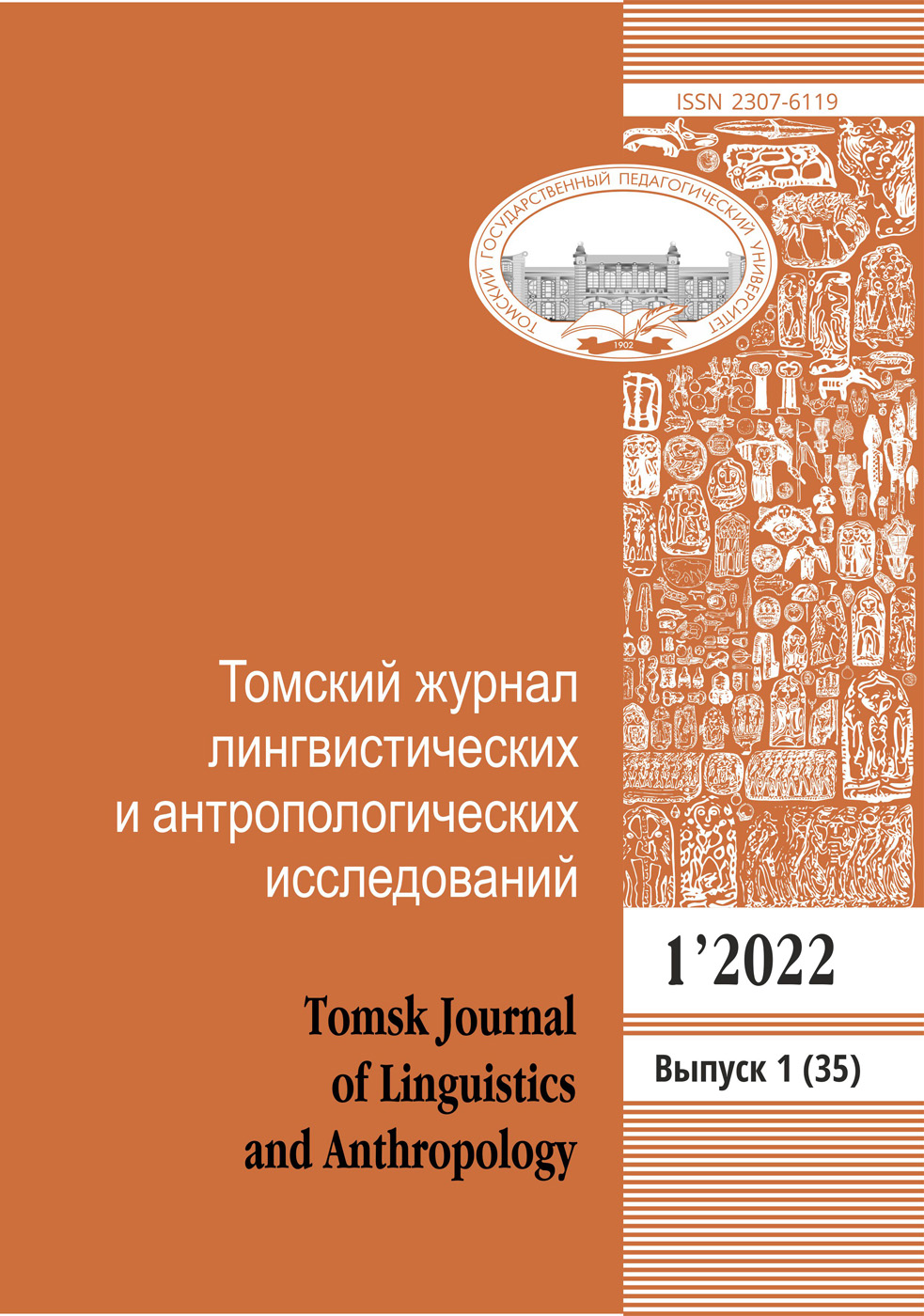COMMUNICATIVE STYLISTICS OF THE TEXT: ASSOCIATIVE NORMS AS A FACTOR OF TEXT FORMATION
The article points to examination of functions of associative words connection in text formation as one of the important factors in dialogue between an author and an addressee of feature text. A text is considered in communicative-action approach as the main form of communication. The research is done in trend of theory of textual associations, which is elaborated in communicative stylistics of text. Typical associations on key stimulus word in the system of feature text are considered in the capacity of associative standards. Standard associations on stimulus word were detected in associative experiment and reflected into Russian Associative Dictionary and then they were correlated with level organization of feature text. This organization consists of informative-notional and pragmatic levels and also corresponded to them sublevels, such as object-logical, thematic, subject-composition in the network of informative-notional level and figurative, emotional and idea-esthetic in the network of pragmatic level. Associative standards as factors of text formation are examined on poetic texts about autumn by Russian poets.
Keywords: communicative stylistics of text, theory of text associations, associative norms, text formation, textual associates, lexical structure of poetic text
References:
1. Bolotnova N. S. Lexical structure of literary text in associative aspect. Tomsk, 1994. 212 p. (in Russian).
2. Bolotnova N. S. Study of associative and semantic word fi elds in feature text. Rusistics: Linguistic paradigm of the end of the XX cc. St. Petersburg, 1998. Pp. 242–247 (in Russian).
3. Bolotnova N. S., Babenko I. I., Vasil’yeva A. A. and others. Communicative stylistics of feature text: lexical structure and idiostyle. Tomsk: TSPU Publ., 2001. 331 p. (in Russian).
4. Bolotnova N. S. The associative fi eld of literary text as refl ection of author's poetic picture of the world. Tomsk State Pedagogical University Bulletin, 2004, no. 1 (38), pp. 20–25 (in Russian).
5. Pushkaryeva I. A. Semantic lexical paradigms in M. I. Tsvetayeva lyrics. Abstract of thesis candidate of philol. sci. Tomsk, 1999. 22 p. (in Russian).
6. Karpenko S. M. Associative word connections in usage and poetic text (on the material of N. S. Gumilyev works). Abstract of thesis candidate of phil. sci. Tomsk, 2000. 26 p. (in Russian).
7. Babenko I. I. Communicative word potential and its refl ection in M. I. Tsvetayeva’s lyrics. Abstract of thesis candidate of philol. sci. Tomsk, 2001. 25 p. (in Russian).
8. Vasil’yeva A. A. Lexical aspect of associative development of poetic texts by O. E. Mandel’shtam. Abstract of thesis candidate of philol. sci. Tomsk, 2004. 30 p. (in Russian).
9. Bolotnov A. V. Verbalisation of “chaos” concept names in poetic discourse of Silver Age (on the material of M. I. Tsvetayeva, V. A. Voloshyn, O. E. Mandel’shtam). Abstract of thesis candidate of philol. sci. Tomsk, 2009. 25 p. (in Russian).
10. Psychology. Dictionary / pod red. A. V. Petrovskogo, M. G. Yaroshevskogo. 2-nd edition, corr. and add. Moscow, 1990. 494 p. (in Russian).
11. Zolotova G. A., Onipenko N. A., Sidorova M. Y. Communicative grammar of the Russian language. Moscow, 1998. 528 p. (in Russian).
12. Dymarskiy M. Ya. Problems of text formation and feature text (on the material of Russian prose of XIX–XX cc.). 2-nd edition, corr. and add. Moscow, 2001. 328 p. (in Russian).
13. Kozhyna M. N. Foundation of functional stylistics. Perm’, 1968. 251 p. (in Russian).
14. Kukharenko V. A. Stylistic organization of fi ction prose. Text linguistics: Materials of science conference. Part 1. Moscow, 1974. Pp. 150–154 (in Russian).
15. Kupina N. A. Linguistic analysis of feature text. Moscow, 1980. 78 p. (in Russian).
16. Bolotnova N. S. Literary text in communicative aspect and complex analysis of lexical units. Tomsk, 1992. 313 p. (in Russian).
17. Bolotnova N. S. Philological analysis of text. Part 3: Text structure. Text formation possibilities of language units. Factors of text formation: tutorial. Tomsk, 2005. 271 p. (in Russian).
18. Bolotnova N. S. Philological analysis of text: tutorial. Moscow, Flinta: Nauka Publ., 2009. 520 p. (in Russian).
19. Tsvetayeva M. I. About art. Moscow, Iskusstvo Publ., 1991. 479 p. (in Russian).
20. Chernukhina I. Y. Common peculiarities of poetic text. Voronezh, 1987. 157 p. (in Russian).
21. Potebnya A. A. Aesthetics and poetics. Moscow, 1976. 614 p. (in Russian).
22. Shcherba L. V. Selected works on the Russian language. Moscow, 1957. 187 p. (in Russian).
23. Dictionary of associative norms of Russian. Pod red. A. A. Leont’yeva. Moscow, 1977. 192 p. (in Russian).
24. Russian associative dictionary: Book 1–6 / Y. N. Karaulov, Y. A. Sorokin, Y. F. Tarasov and others. Moscow, 1994–1998; Russian associative dictionary: 2 vol. Vol. 1. From stimulus to reaction / Y. N. Karaulov, G. A. Cherkasova, N. V. Ufi mtseva and others. Moscow, 2002. 784 p.; Vol. 2. From reaction to stimulus / Y. N. Karaulov, G. A. Cherkasova, N. V. Ufi mtseva and others. Moscow, 2002. 992 p. (in Russian).
25. Karaulov Yu. N. Language building and thesaurus of literary language. Moscow, 1981. 336 p. (in Russian).
26. Suprun A. E., Klimenko A. P., Titova L. N. Typology of associative structures and vocabulary study. Russian at national school, 1974, no. 3, pp. 4–11. (in Russian).
27. Stepanova V. V. Functional key points in word’s semantic and their textual implementation. Problems of word research in fi ction text. St. Petersburg, 1990. Pp. 4–17. (in Russian).
28. Klimenko A. P. Associative fi eld and text. Functioning and development of language systems. Minsk, 1990. Pp. 44–46. (in Russian).
29. Klimkova L. A. Associative word meaning in fi ction text. Scientifi c report of Higher school: Philological sciences, 1991, no. 1, pp. 45–54 (in Russian).
Issue: 9, 2014
Series of issue: Issue 9
Rubric: COMMUNICATIVE STYLISTICS OF THE TEXT
Pages: 32 — 39
Downloads: 960





